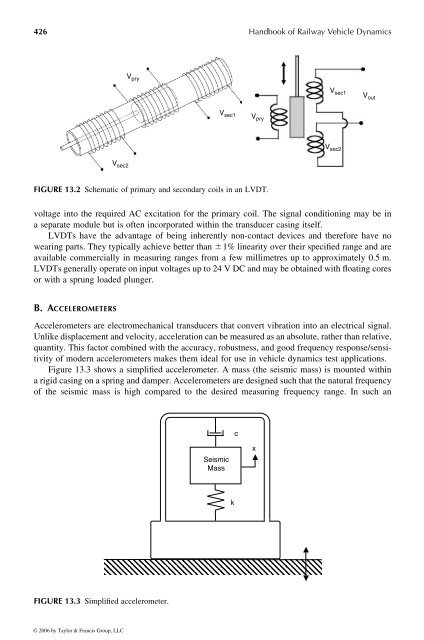Create successful ePaper yourself
Turn your PDF publications into a flip-book with our unique Google optimized e-Paper software.
426<br />
voltage into the required AC excitation for the primary coil. The signal conditioning may be in<br />
aseparate module but is <strong>of</strong>ten incorporated within the transducer casing itself.<br />
LVDTs have the advantage <strong>of</strong> being inherently non-contact devices and therefore have no<br />
wearing parts. They typically achieve better than ^ 1% linearity over their specified range and are<br />
available commercially in measuring ranges from afew millimetres up to approximately 0.5 m.<br />
LVDTsgenerally operate on input voltagesupto24VDC and may be obtained with floating cores<br />
or with asprung loaded plunger.<br />
B. A CCELEROMETERS<br />
V sec2<br />
V pry<br />
Accelerometers are electromechanical transducers that convert vibration into an electrical signal.<br />
Unlikedisplacement and velocity, acceleration can be measured as an absolute, rather than relative,<br />
quantity. This factor combined with the accuracy, robustness, and good frequency response/sensitivity<br />
<strong>of</strong> modern accelerometers makes them ideal for use in vehicle dynamics test applications.<br />
Figure 13.3 shows asimplified accelerometer. Amass (the seismic mass) is mounted within<br />
arigid casing on aspring and damper. Accelerometersare designed such that the natural frequency<br />
<strong>of</strong> the seismic mass is high compared to the desired measuring frequency range. In such an<br />
V sec1<br />
V pry<br />
FIGURE 13.2 Schematic <strong>of</strong> primary and secondary coils in an LVDT.<br />
FIGURE 13.3 Simplified accelerometer.<br />
© 2006 by Taylor & Francis Group, LLC<br />
Seismic<br />
Mass<br />
k<br />
c<br />
<strong>Handbook</strong> <strong>of</strong> <strong>Railway</strong> <strong>Vehicle</strong> <strong>Dynamics</strong><br />
x<br />
V sec1<br />
V sec2<br />
V out









